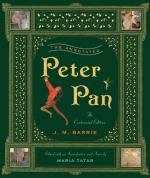|
This section contains 296 words (approx. 1 page at 400 words per page) |

|
Peter Pan Summary & Study Guide Description
Peter Pan Summary & Study Guide includes comprehensive information and analysis to help you understand the book. This study guide contains the following sections:
This detailed literature summary also contains Bibliography and a Free Quiz on Peter Pan by J. M. Barrie.
Peter Pan, which was alternately titled "The Boy Who Would Not Grow Up," was first performed in London, England, on December 27, 1904, at the Duke of York Theatre. It has since become one of the most widely performed and adapted children's stories in the world. It is also Barrie's best-known work, though he was a prolific author writing in a number of genres. Critics believe that one reason Peter Pan was successful from the first is that Barrie combined fantasy and adventure in a way not done before. The play offers a fresh means of storytelling that appeals to both adults and children. While children enjoy the imaginative story and flights of fancy, adults can relate to Peter Pan's desire to forego mature responsibilities and live in the moment. Roger Lancelyn Green wrote in his book Fifty Years of Peter Pan: "Peter Pan is the only children' s play that is also a great work of literature."
The text of the play has evolved since it was first performed in 1904. The original stage production of Peter Pan was only three acts. Barrie let the story grow through several novels and different versions of the stage play to arrive at a standardized text by 1928. The playwright claimed that he did not remember writing the play, which began as a backyard amusement for some of his young friends. After its London debut, Peter Pan became an annual Christmas event in that city's theater district for several decades. The play has also been adapted into a musical stage version as well as several different kinds of movies. Ironically, considering the play's prominent theme of motherhood, Peter Pan is traditionally played by a young woman, while Nana the dog is usually played by a man in a dog suit.
Read more from the Study Guide
|
This section contains 296 words (approx. 1 page at 400 words per page) |

|



